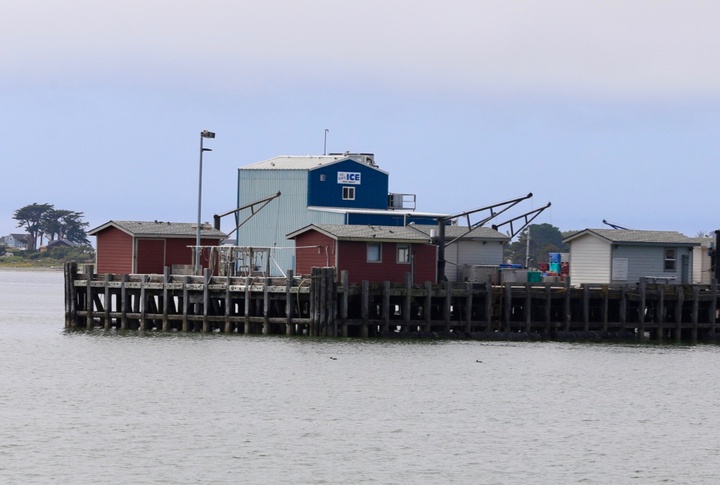Jessica Cejnar Andrews / Friday, Jan. 12, 2024 @ 4:11 p.m.
Sea-to-Market Program Gets Coastal Conservancy Grant, Will Offer Local Seafood to Del Norters This Summer

Citizens Dock at the Crescent City Harbor. | File photo: Andrew Goff
Previously:
• Sea to Market Project Aims to 'Shorten Supply Chain' Between Local Fishermen, Del Norters
###
A 23-year commercial fisherman working to provide an avenue for fellow anglers to sell their catch locally has received a boost from the California Coastal Conservancy.
The $260,100 grant will be used to construct a dedicated restroom and storefront that will coincide with the fish fillet station Josh Mims and the Community Food Council established at the Crescent City Harbor.
The Del Norte Public Health Branch required both the restroom and storefront for the Food Council’s Sea-to-Market project to get up and running, Mims told the Wild Rivers Outpost on Wednesday.
“We hoped to be running before the end of the summer,” he said. “Now with crab season, we’re hoping to be up and running come mid-spring. What I mean by running, [we’ll] have a fillet facility for local rock fishermen, salmon fishermen and tuna fishermen to have a place to come in and process their catch.”
Those fishermen will be able to sell their product to the consumer directly from the storefront during the Farmers Market, Mims said.
The Sea-to-Market project is the brainchild of Community Food Council Director Andrea Lanctot. In 2020, the organization, which operates under the umbrella of the Family Resource Center of the Redwoods, started the North Coast Fresh From the Sea program. Over about two years locals purchased 6,865 pounds of fish, according to a January Food Council newsletter.
This program allowed several fishermen to sell their full quota of rockfish to Del Norters for the first time in years, according to the California Coastal Conservancy’s Nov. 30, 2021 staff report.
Last year, using a $276,000 NOAA grant, the Food Council contracted with Phoenix-based Integrated Modular Solutions and Santa Barbara-based Container Concepts to build the fillet facility.
The 40-foot shipping container is outfitted with three fillet stations and was completed in August 2023, according to a Food Council newsletter.
According to Mims, the Food Council had planned on using one of the bathrooms at the Harbor but found that the Public Health Branch required a dedicated restroom at the fillet processing station.
“Everything got stalled out for a few months because of the requirement for the bathroom,” Mims said. “The pop-up storefronts will allow them a place to sell their product from during the Farmers Market.”
Commercial fishing vessels land salmon, shrimp, tuna, cod and Dungeness crab at the Crescent City Harbor.
According to the Coastal Conservancy’s Nov. 30 staff report, the harbor has struggled due to decreasing fish stocks and more restrictive regulations. The Conservancy’s staff report also mentions the cancelled salmon and nearshore groundfish fisheries.
The Harbor District doesn’t have the infrastructure to provide local processing and direct marketing to small fishermen. Much of the seafood coming through Citizens Dock are purchased by wholesalers Caito and Pacific Choice Seafood and shipped out of state for processing. They also set the prices and determine the species they will take, according to the Coastal Conservancy’s staff report.
“In order to keep working waterfronts viable and commercial fishermen supported, local processing and marketing infrastructure must be developed as an alternate path to national supply chains,” Coastal Conservancy staff stated.
“We are really excited about it,” Assistant Harbormaster Mike Rademaker said. “We know once the word gets out, the public will be equally enthusiastic. We are kicking around some alternative names for the project, such as ‘Port to Plate.’”
Anglers from roughly six fishing vessels are excited about the project, Mims told the Outpost. They’re currently navigating muddy waters due to the nearshore groundfish fisheries closure from last year and are trying to make plans for this year, he said. Next year’s salmon season has also been canceled.
When asked how the endeavor will remain sustainable, Mims said operating costs should cost less than $500 a month. The Food Council is also brainstorming other potential products to sell such as digital cookbooks, sweatshirts and hats.
“I’ve spoken with the fishermen,” Mims said. “‘[They’ll] be responsible for cleaning up after themselves. If we have to hire people to run that and keep it clean, obviously the cost is going to go up. Something like this has never been done so we’re not 100 percent positive on how it’s going to go.”
One potential revenue stream could be an ice vending machine that provides 10-pound bags of ice for $3-5. Another is for fishermen to provide a few cents toward the project for every pound of seafood they sell, Mims said.
“Our main goal is to keep costs down as much as possible. Fishermen are facing enough challenges and we would like to support them in any way we can,” he said.
CLICK TO MANAGE